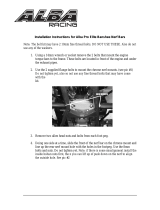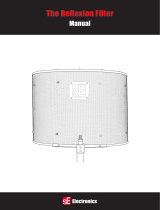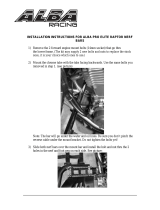Page is loading ...

The Ophthalmoscope
Transparency of the cornea, lens and vitreous humor
permits the physician to directly view arteries, veins, optic
nerve and the retina.
Direct observation of the structures of the fundus through an
ophthalmoscope may show disease of the eye itself or may
reveal abnormalities indicative of disease elsewhere in the
body. Among the most important of these are vascular
changes due to diabetes or hypertension and swelling of the
optic nerve head due to papilledema or optic neuritis. In this
sense, the eye serves as a window through which many
valuable clinical evaluations may be made.
When a preliminary diagnosis of an imminently dangerous
eye condition, such as acute glaucoma or retinal
detachment, is made by the examiner, prompt referral to an
ophthalmologist may prevent irreversible damage. Or, when
distressing but less urgent conditions, such as visual
impairment due to cataract or vitreous floater are
recognized, the patient can be reassured and referred.
A. Front surface mirror
B. Crossed linear
polarizing/red-free
filter switch
C. Aperture selection
disc
D. On/Off rheostat
control
E. Rubber brow rest
F. Lens selection disc
G. Illuminated lens
indicator
Acknowledgment
We wish to express our sincere appreciation to the Scheie Eye Institute and
Dr. Steven Koenig, Dr. Ralph Eagle, Dr. Ken Spitzer and John Griffin for their
contribution to this booklet.
A
B
C
D
E
F
G
• Ophth Broch ForeignWorking.2 4/26/99 1:02 PM Page 2

1
Standard apertures
There is a wide range of practical apertures to select from:
micro spot, small spot, large spot, fixation, slit and cobalt
blue filter. A red-free filter is also available for use on the
apertures. This selection of apertures covers all the
physician’s needs in an ophthalmologic examination.
A. Micro spot aperture: Allows quick visual entry in very
small, undilated pupils.
B. Small aperture: Provides easier view of fundus through
an undilated pupil. Always start examination with this
aperture, proceed to large aperture as pupil adapts to light.
C. Large aperture: Standard aperture for dilated pupil and
general examination of the eye.
D. Fixation aperture: The pattern of an open center and
thin lines permits easy observation of eccentric fixation
without masking the macula.The graduated cross hairs can
be used to estimate either the amount of eccentric fixation
relative to the macula or the size or location of a lesion on
the retina or choroid.
NOTE: When viewed outside the patient at a distance less
than 40", the fixation aperture will be out of focus. The lens
of the eye will insure correct focus on the fundus.
E. Slit or streak: Helpful in determining various levels of
lesions, particularly tumors and edematous discs.
F. Cobalt blue filter: When fluorescein dye is injected into
the vein of a patient, the physician can observe the
movement of this fluid within the vessels. When viewed
through the cobalt filter of the ophthalmoscope, the dye will
appear as a yellow/green color. If any vessel is abnormal,
leaking or hemorrhaging, the cobalt filter will reveal this
problem. Flourescein drops in the eye may also help
detect corneal abrasions and other lesions.
Other filters
Welch Allyn ophthalmoscopes #11720 and #11730 are
equipped with a unique sliding switch that greatly increases
their versatility.
• Ophth Broch ForeignWorking.2 4/26/99 1:02 PM Page 1

Red-free filter: When the switch is positioned to the left (while
facing the instrument front) it will be beneath a green dot and the
red-free filter will be in place. This can be used in conjunction with
any aperture. The red-free filter excludes red rays from the
examination field; this is superior to ordinary light in viewing slight
alterations in vessels, minute retinal hemorrhages, ill-defined
exudates and obscure changes in the macula. The nerve fibers
become visible and the observer may note the disappearance of
such fibers, as in optic nerve atrophy. The background appears gray,
the disc appears white, the macula appears yellow, the fundus reflex
is intense and the vessels appear almost black. This filter is also
used to help distinguish veins from arteries...veins stay relatively
blue, but oxygenated arterial blood makes arteries appear blacker.
This makes differentiation easier for the examiner.
Crossed linear polarizing filter: When the switch is positioned to
the right (while facing the instrument front) it will be beneath a while
circle with crosshairs inside. The crossed linear polarizing filter will
be in place. This filter is used to eliminate corneal glare and
reflection and can be used with any aperture. For more information
on this filter turn to page 9.
Additional uses for the ophthalmoscope
In addition to examination of the fundus, the
ophthalmoscope is a useful diagnostic aid in studying other
ocular structures. The light beam can be used to illuminate
the cornea and the iris for detecting foreign bodies in the
cornea and irregularities of
the pupil. By placing the +15.00 lens in the scope and
looking at the pupil as in fundus examination
[2 inches (5cm) distance from patient], the
physician may verify doubtful pupillary action.
The practitioner can also easily detect lens opacities by
looking at the pupil through the +6 lens setting at a distance
of 6 inches (15cm) from the patient. In the same manner,
vitreous opacities can be detected by having the patient look
up and down, to the right and to the left. Any vitreous
opacities will be seen moving across the pupillary area as
the eye changes position or comes back to the primary
position.
2
• Ophth Broch ForeignWorking.2 4/26/99 1:02 PM Page 2

3
The Eye
With the ophthalmoscope 2 inches (5cm) in front of the eye,
the lenses in the rotating wheel produce clear vision at
points indicated in the diagrammatic eye.
The hyperopic or far-sighted eye requires more “plus” sphere
for clear focus and the myopic or
near-sighted eye requires “minus” sphere for clear focus.
VITREOUS HUMOR
RETINA
OUTSIDE
LENS
INSIDE
LENS
ANTERIOR
CORNEA
• Ophth Broch ForeignWorking.2 4/26/99 1:02 PM Page 3

A. Macula
B. Vitreous humor
C. Sclera
D. Choroid
E. Retina
F. Ora Serrata
G. Canal of Schlemm
H. Anterior chamber
I. Iris
4
J. Cornea
K. Ciliary Body
L. Zonule (Suspensory Ligament)
M. Conjunctiva
N. Lens
O. Hyaloid canal
P. Central retinal vein
Q. Optic nerve
R. Central retinal artery
• Ophth Broch ForeignWorking.2 4/26/99 1:02 PM Page 4

5
How to Conduct an
Ophthalmologic Examination
Position the ophthalmoscope
about 6 inches (15cm) in front
and 25° to the right side of
the patient. (Step 5)
In order to conduct a
successful examination
of the fundus, the
examining room should
be either semi-darkened
or completely darkened.
It is preferable to dilate
the pupil when there is
no pathologic contrain-
dication, but much
information can be
obtained through the
undilated pupil.
The following steps will help the physician obtain satisfactory
results:
1. For examination of the right eye, sit or stand at the
patient’s right side.
2. Select “0” on the illuminated lens dial of the
ophthalmoscope and start with small aperture.
3. Take the ophthalmoscope and start in the right hand and
hold it vertically in front of your own right eye with the light
beam directed toward the patient and place your right
index finger on the edge of the lens dial so that you will be
able to change lenses easily if necessary.
4. Dim room lights. Instruct the patient to look straight ahead
at a distant object.
5. Position the ophthalmoscope about 6 inches (15cm) in
front and slightly to the right (25°) of the patient and direct
the light beam into the pupil. A red “reflex” should appear
as you look through the pupil.
• Ophth Broch ForeignWorking.2 4/26/99 1:02 PM Page 5

6
6. Rest the left hand on the patient’s forehead and hold the
upper lid of the eye near the eyelashes with the thumb.
While the patient holds his fixation on the specified object,
keep the “reflex” in view and slowly move toward the
patient. The optic disc should come into view when you are
about 1
1
/2 to 2 inches (3-5cm) from the patient.
If it is not focused clearly, rotate lenses into the aperture
with your index finger until the optic disc is as clearly visible
as possible. The hyperopic,
or far-sighted, eye requires more “plus” (black numbers)
sphere for clear focus of the fundus; the myopic, or near-
sighted, eye requires “minus” (red numbers) sphere for
clear focus.
7. Now examine the
disc for clarity of
outline, color,
elevation and
condition of the
vessels. Follow
each vessel as far
to the periphery as
you can. To locate
the macula, focus
on the disc, then
move the light
approximately 2
disc diameters
temporally. You
may also have the
patient look at the
light of the ophthal-
moscope, which will
automatically place
the macula in full
view. Examine for
abnormalities in the
macula area. The
red-free filter facilitates viewing of the center of the macula,
or the fovea.
• Ophth Broch ForeignWorking.2 4/26/99 1:02 PM Page 6

8. To examine the extreme periphery, instruct the patient to:
a) look up for examination of the superior retina
b) look down for examination of the inferior retina
c) look temporally for examination of the
temporal retina
d) look nasally for examination of the nasal retina.
This routine will reveal almost any abnormality
that occurs in the fundus.
9. To examine the left eye, repeat the procedure outlined
above except that you hold the ophthalmoscope in the
left hand, stand at the patient’s left side and use your left
eye.
CAUTION:
Before actuating the red-free filter/crossed linear polarizing
filter slide switch, pull the instrument away from the patient’s
face to prevent contact with finger or switch.
Examine the disc for clarity of outline, color, elevation and condition of
the vessels. (step 7)
Overcoming corneal reflection
One of the most troublesome barriers to a good
view of the retina is the light reflected back into the
examiner’s eye by the patient’s cornea — a condition know
as corneal reflection.
1. On the ophthalmoscope shown in this book, the crossed
linear polarizing filter may be used. This filter reduces the
corneal reflection by 99%. To engage, simply move the
switch on the front of the instrument to the position
underneath the white crosshairs. It is recommended that
the crossed linear polarizing filter be used when corneal
reflection is present.
2. Use the small spot aperture. However, this reduces the
area of the retina illuminated.
3. Direct the light beam toward the edge of the
pupil rather than directly through its center. This
technique can be perfected with practice.
7
• Ophth Broch ForeignWorking.2 4/26/99 1:02 PM Page 7

Common Pathology of the Eye
Häufige pathologische Befunde am Augenhintergrund/
Pathologie courante de l’œil/Patologías comunes del ojo/
Patologie comuni dell’occhio
Normal fundus
Disc: Outline clear; physiological cup is pale area centrally
Retina: Normal red/orange color, macula is dark avascular area temporally
Vessels: Arterial — venous ratio 2 to 3; the arteries appear a bright red, the
veins a slightly purplish color
Fond de l’œil normal
Papille : Contour clair ; l’excavation de la papille est la zone pâle au centre
Rétine : Couleur rouge orangé normale, la macula est la zone sombre non
vascularisée
Vaisseaux : On trouve deux artères pour trois veines ; les artères sont d’un
rouge vif et les veines, légèrement violacées
Normaler Fundus
Papille: Klarer Umriß; der helle Bereich zentral ist die physiolog.
Excavation der Papille
Retina: Rot / orangefarben, die Macula ist der dunkle avaskuläre Bereich
temporal
Gefäße: Verhältnis der Gefäßdicke Arterien: Venen = 2:3; Arterien
erscheinen hellrot, Venen eher violett rot
Fondo normal
Disco: Contorno claro; área de copa fisiológica pálida en el centro.
Retina: Color normal rojo/anaranjado, mácula oscura, área avascular en
dirección temporal.
Vasos: Arteriales – relación venosa 2 a 3; las arterias se ven de color rojo
brillante, las venas de un color ligeramente morado.
40
• Ophth Broch ForeignWorking.2 4/26/99 1:04 PM Page 40

Fondo normale
Disco: Contorno nitido, la coppa fisiologica è un’area pallida verso il centro.
Retina: Normale se di colore rosso/arancio; la macula corrisponde all’area
avascolare scura nella zona temporale.
Vasi: Rapporto arterie/vene di 2 a 3; le arterie appaiono di un rosso
brillante, le vene di colore leggermente purpureo.
Hypertensive retinopathy (advanced malignant)
Disc: Elevated, edematous disc; blurred disc margins
Retina: Prominent flame hemorrhages surrounding vessels near disc border
Vessels: Attenuated retinal arterioles
Rétinopathie hypertensive (tumeur maligne avancée)
Papille : Papille surélevée et œdémateuse au bord flou
Rétine : Hémorragies manifestes en flammèches autour des vaisseaux situés
près du bord de la papille
Vaisseaux : Artérioles rétiniennes rétrécies
Retinopathie hypertensiva (fortgeschritten)
Papille: Prominent, ödematöse Papille; unscharfe Ränder
Retina: Steifige peripapilläre Blutungen
Gefäße: Enggestellte Arterien
Retinopatía hipertensora (maligna avanzada)
Disco: Disco elevado, edematoso; márgenes borrosos del disco.
Retina: Hemorragias como llamas prominentes rodeadas de vasos cerca del
borde del disco.
Vasos: Arteriolas retinales atenuadas.
Retinopatia ipertensiva (stadio maligno avanzato)
Disco: Disco edematoso e sollevato; margini confusi.
Retina: Premineneti aree emorragiche intorno ai vasi e sui bordi del disco.
Vasi: Arteriole retiniche ridotte.
41
• Ophth Broch ForeignWorking.2 4/26/99 1:04 PM Page 41

42
Proliferative diabetic retinopathy
Disc: Net of new vessels growing on disc surface
Retina: Numerous hemorrhages, new vessels at superior disc margin
Vessels: Dilated retinal veins
Rétinopathie diabétique proliférante
Papille : Apparition d’un réseau de nouveaux vaisseaux à la surface de la
papille
Rétine : Nombreuses hémorragies, nouveaux vaisseaux sur le bord
supérieur de la papille
Vaisseaux : Veines rétiniennes dilatées
Proliferative diabetische Retinopathie
Papille: Netz neuer Gefäße auf der Papillenoberfläche
Retina: Zahlreiche Blutungen, neue Gefäße am oberen Papillenrand
Gefäße: Erweiterte Venen
Retinopatía diabética proliferativa
Disco: Red de nuevos vasos que crecen en la superficie del disco.
Retina: Numerosas hemorragias, nuevos vasos en el margen superior del
disco.
Vasos: Venas retinales dilatadas.
Retinopatia diabetica proliferativa
Disco: Rete di nuovi vasi che si sviluppa sulla superficie del disco.
Retina: Numerose emorragie, nuovi vasi sul margine superiore del disco.
Vasi: Vene retiniche dilatate.
• Ophth Broch ForeignWorking.2 4/26/99 1:04 PM Page 42

43
Papilledema
Disc: Elevated, edematous disc, blurred disc margins; vessels engorged
Retina: Flame retinal hemorrhage close to disc
Vessels: Engorged tortuous veins
Œdème papillaire
Papille : Papille surélevée et œdémateuse au bord flou ; vaisseaux engorgés
Rétine : Hémorragie rétinienne en flammèches près de la papille
Vaisseaux : Veines sinueuses et engorgées
Papillenödem
Papille: Prominent, ödematöse Papille; unscharfe Ränder, Gefäße zur Papille
aufsteigend
Retina: Rote Netzhautblutungen nahe dem Diskus
Gefäße: Erweiterte Venen, vermehrt geschlängelter Verlauf
Papiledema
Disco: Disco elevado, edematoso, márgenes borrosos; vasos
congestionados.
Retina: Hemorragia retinal como llama cerca del disco.
Vasos: Venas tortuosas congestionadas.
Edema della pupilla
Disco: Disco edematoso e sollevato; margini confusi; vasi ostruiti.
Retina: Emorragie retiniche a fiamma vicino al disco.
Vasi: Vene ostruite e tortuose.
• Ophth Broch ForeignWorking.2 4/26/99 1:04 PM Page 43

45
Retinal detachment
Disc: Normal
Retina: Gray elevation in temporal area with folds in detached section
Vessels: Tortuous and elevated over detached retina
Décollement de la rétine
Papille : Normale
Rétine : Soulèvement de couleur grise dans la région temporale avec replis
dans la section décollée
Vaisseaux : Sinueux et surélevés sur la rétine décollée
Netzhautablösung
Papille: Normal
Retina: Temporal grau erhabene Ablösung mit Falten im abgelösten Bereich
Gefäße: Vermehrt geschlängelt im abgelösten Netzhautbereich
Desprendimiento de la retina
Disco: Normal.
Retina: Elevación gris en el área temporal con pliegues en la sección
desprendida.
Vasos: Tortuosos y elevados sobre la retina s desprendida.
Distacco della retina
Disco: Normale.
Retina: Elevazione grigia nell’area temporale con pieghe nella sezione
distaccata.
Vasi: Tortuosi e sollevati sopra la retina distaccata.
• Ophth Broch ForeignWorking.2 4/26/99 1:04 PM Page 45

Welch Allyn, Inc.
4341 State Street Road
P.O. Box 220
Skaneateles Falls, NY 13153-0220
U.S.A.
Phone: (800) 535-6663 FAX: (315) 685-3361
(315) 685-4560
PM117072-01 Rev. B Printed in U.S.A.
• Ophth Broch ForeignWorking.2 4/26/99 1:04 PM Page 46
/












